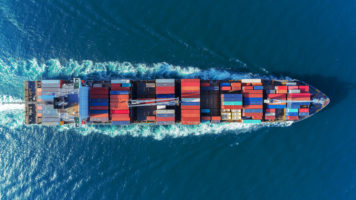
What type of shipping is right for you?

To meet customer demands and deliver value back to the bottom line, supply chain professionals are always looking for ways to optimize their processes. In this sense, choosing the optimal method of shipping is critical as this is the issue that will have the most significant impact on profitability and overall service delivery.
While one method may be best for some cargo, it may not be suitable for another. To help inform your decisions, we’re taking a deeper dive into the pros and cons of each type of shipping, the good, the bad, and the ugly.
Ground Shipping: Pros and Cons

Slow, steady, and (mostly) reliable, ground shipping definitely has its merits. But there’s a dark side, too.
Ground Shipping Pros:
1. Value
Compared to air and rail, over-the-road shipping (OTR) is much less expensive.
2. Destination flexibility
One of the greatest advantages to OTR shipping is that, in most cases, it is door-to-door. Anywhere a vehicle can drive to is a good candidate for ground shipping.
Ground Shipping Cons:
1. Delays
As with any motorized vehicle, there is potential for breakdowns, delays due to traffic, accidents, injury, illness, and so on. If your shipment simply must arrive at a predictable time, OTR might not be your best bet.
2. Security Concerns
Theft and breakage are typically higher than with other types of shipping.
3. Size Restrictions
Depending on the volumes of goods you are shipping, OTR might not be as practical. However, it might still be more efficient and economical to ship on a fleet of trucks than it would be on several airplanes.
Rail Shipping: Pros and Cons

Rail transport is a common method of shipping that can be used to transport a wide array of goods. From livestock to vehicles, to frozen products and more, rail transport offers many advantages, but it does have its limitations.
Rail Shipping Pros:
1. Flexibility
On the plus side, shipping by rail is flexible. You can ship just about anything in any quantity, and it can potentially reduce the cost of transport by hundreds of dollars per load compared to OTR (ground) shipments.
2. Perishable or High-Value Goods
If you are shipping perishable goods or items that require a strictly controlled environment, rail shipping provides confidence that your load will arrive as expected.
3. Predictable Timelines
Despite the increase in traffic on major freight routes, trains generally are not subject to as many delays as trucks and can provide a consistent and reliable timeline from end to end.
4. Economy
If you are shipping a smaller load, a rail shipping option may be more economical as the capacity price variation does not fluctuate nearly as much as it does when compared to ground.
Rail Shipping Cons:
1. Destination Inflexibility
Rail lines don’t always go where you need your shipment to be, so intermodal transportation may be necessary in order to get you there.
2. Physical Restrictions
Shipments are limited to height restrictions based on passage requirements.
3. Not Practical For Short Distances
Over a short distance, rail can be much slower and more expensive than an over-the-road (OTR) solution.
The takeaway: intermodal transport, combining OTR and rail, may be the best solution.
Air Shipping: Pros and Cons

Air shipping provides great flexibility and expedience, but is the value there?
Air Shipping Pros
1. Super Fast
Air shipping gives you ultimate timeline flexibility, satisfying customer demands. By comparison, an overseas shipment may take 30 days or more, whereas air shipping can take 48 hours or less.
2. Global Reach
Just about any destination is reachable by air.
3. Low Risk
Shipments are highly trackable with online tools, allowing better reliability from end-to-end.
Air Shipping Cons:
1. Cost
Because the cost is calculated by weight and not volume, air shipping can be quite high, especially for large or heavy shipments. The difference between ocean and air rates can be thousands of dollars.
2. Size and Weight Restrictions
Planes can only carry so much in terms of size and weight so some shipments may not be possible by air.
3. Regulations
Shippers are subject to more stringent regulations when shipping by air. Hazardous materials, firearms, and some chemicals are a no-go.
Ocean Shipping: Pros and Cons

For large-scale global shipping, ocean transport is sometimes the best choice.
Ocean Shipping Pros:
1. Economy
Compared with air freight, ocean transport is very economical.
2. Ideal for Large, Heavy Shipments
If you have containers filled with heavy goods, like machine parts, vehicles, or shipments of a similar nature, there is really no other choice but to send it by ocean if you want to keep costs reasonable.
Ocean Shipping Cons:
1. It's Slow
A container ship can only travel so fast. If you need your shipment to arrive quickly, ocean shipping is not the best choice.
2. High Risk
There is great potential for containers to be lost at sea. Volatile weather conditions, overloading of ships, and catastrophic events, including piracy, have accounted for more than 1,400 containers being lost without a trace
every year.
3. Not Ideal for Perishable or Temperature-Sensitive Goods
Without the ability to monitor conditions within the container, it is challenging to provide any reliable quality assurance.
4. Environmentally Unsustainable
Though ocean shipping has long been seen as a greener way to go, with the number of ships on the ocean continuing to rise, environmentalists have begun to raise concerns about the impact on marine life. The whale population, in particular, is suffering greatly from the increased noise in the ocean, making it difficult for them to find food. Additionally, the number of accidents at sea are on the rise, some of which have introduced deadly pollutants into the water.
How ShipERPTM Can Help You With Various Types of Shipping
ShipERP is an SAP-powered multi-carrier shipping solution that can optimize your supply chain through every channel. We provide a robust shipping platform that helps you save time and money while delivering the ultimate peace of mind of knowing exactly where your shipment is at any given time. Reach out to our team today to learn more about how you can optimize your shipping.
